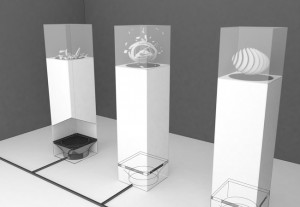Thesis Showcase: Caitlin Morris Turns Soundwaves Into Art
 In this series, second-year D&T MFA students explain what they are doing with their thesis projects, where they apply what they’ve been learning toward their personal interests. Below, Caitlin Morris describes her vision of reshaping our perception of sound through an art installation. By Rachel Signer.
In this series, second-year D&T MFA students explain what they are doing with their thesis projects, where they apply what they’ve been learning toward their personal interests. Below, Caitlin Morris describes her vision of reshaping our perception of sound through an art installation. By Rachel Signer.
What’s the main idea of your project?
It’s an installation and performance piece that plays on the idea that we lock ourselves into sensory experiences—for example, we perceive sound as something we hear rather than something tangible. There are soundwaves being played near sculptural objects, and the sculptures are being physically destroyed by the sound waves as they impact them. So, it’s taking this phenomenon that we usually think of as a non-tangible thing, and showing how it is physical, and questioning the boundary we assume exists between sensory experiences as one thing or another. I consider myself an artist, and my background is in architecture and architectural acoustics, and cognitive science, but now my approach is more artistic. The sculptures will fit on plinths, which will resonate the sound from the bottom through the sculptures.
I’ve had to experiment with audio equipment to get low-frequency sound waves—things that wouldn’t occur normally. So I had to buy that myself, but I didn’t really mind the cost because a lot of the work I do is about sound and space, so I’ll continue using it. I also will have the costs of the materials for the sculptures myself—but I’m using excess from cast making, so that’s free.
Does your project have a business model or plan for moving forward?
The project is an installation, so I’m looking forward to the thesis show as an opportunity to test it out, and then I’d like to keep showing it at galleries. The thesis show will one instance in a larger series of things I’m interested in doing.
What has been the most challenging aspect of your project?
I started off with a lot of interests that I wanted to explore. Making the decisions about what to include in my project, and what to cut out, was difficult. I had to focus on what would resonate with other people the best. I did it through conversations with my advisors and peers, both people in the lab and out of the lab, and some testing to see what was practical, and also self-reflection.
What surprised you while you were working on it?
During the process, you don’t feel like you’re making progress, but then you look back and realize how what you’re doing now is so much more developed than what you had a month or a year prior. So, the realization that I’m actually making a lot of progress is a pleasant surprise.
How has this program been supportive to your project?
Many ways. I can’t imagine doing this project without all the classes I’ve taken and the critics I’ve talked to, both among the faculty and my peers. Students here are really good at giving feedback; even if it’s a friend, he won’t be afraid to give some constructive criticism. I’ve been able to work on projects around sound as an art form in studio classes here, and that’s really helped me because I thought before that my thesis project on sound would be some large, kinetic, architectural structure, but now, because of the work I’ve done here with generating sound algorhythmically, and working with installation-based projects, those things have definitely informed where I am. Also, being in the city you can see so much work that inspires you and provides context for understanding a larger context.

